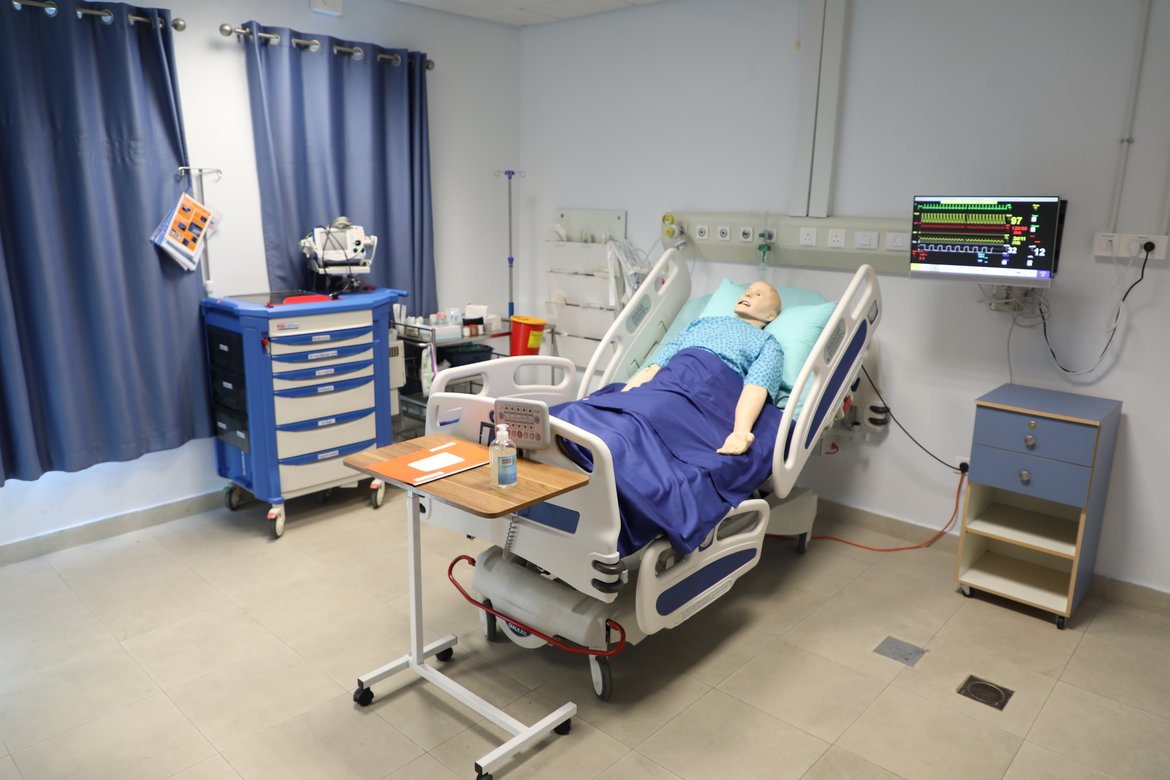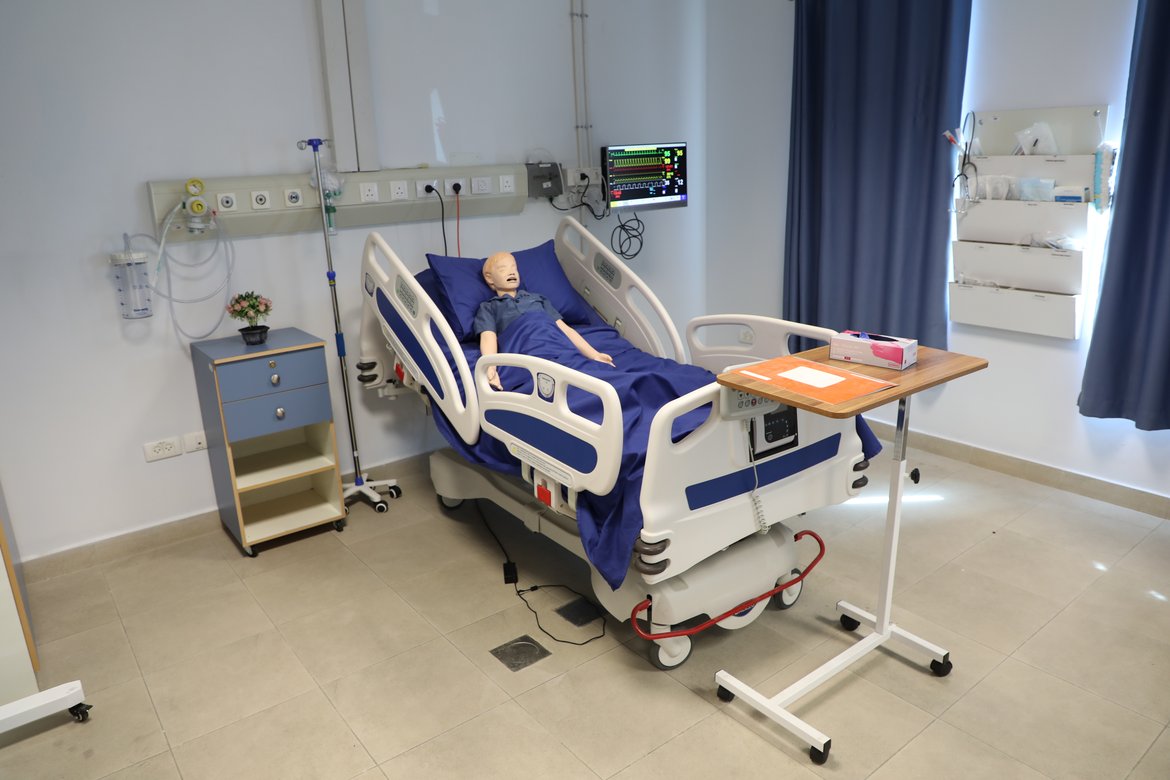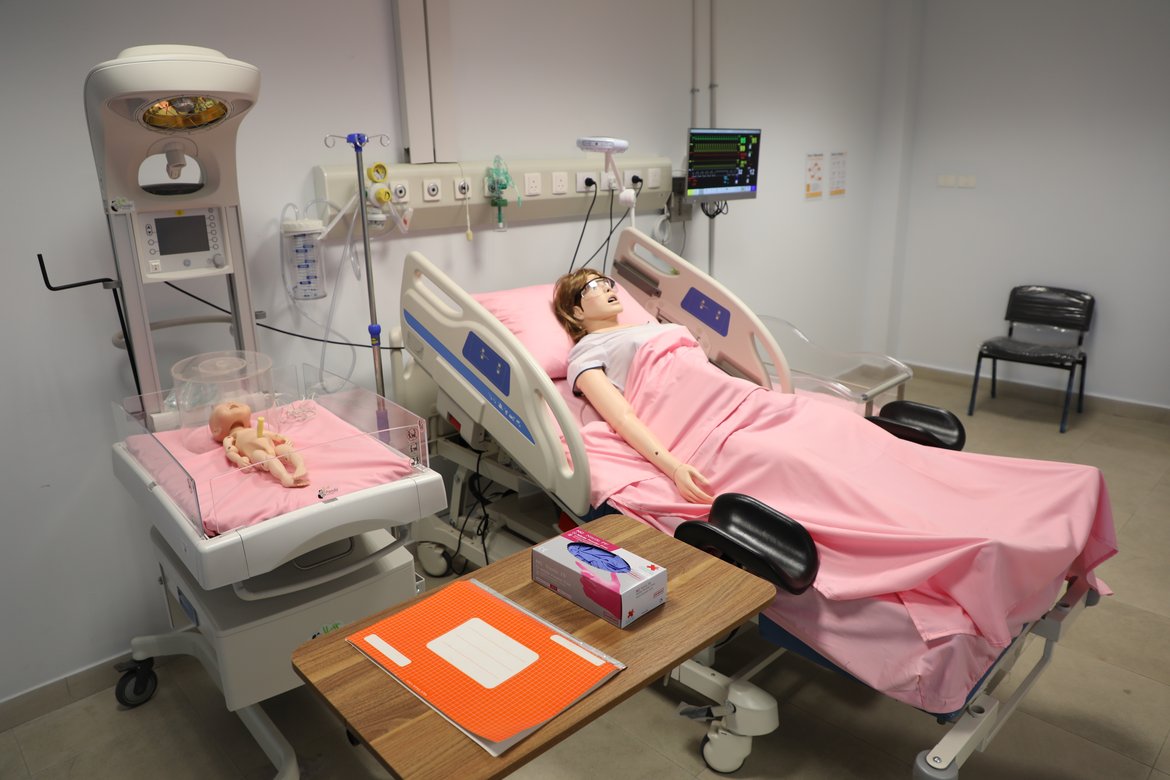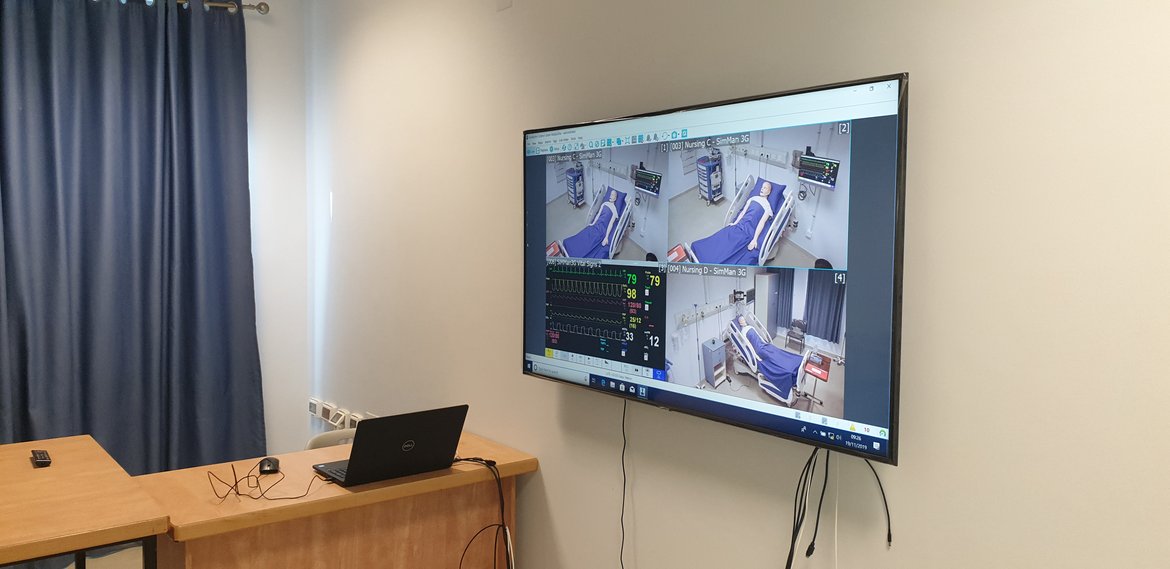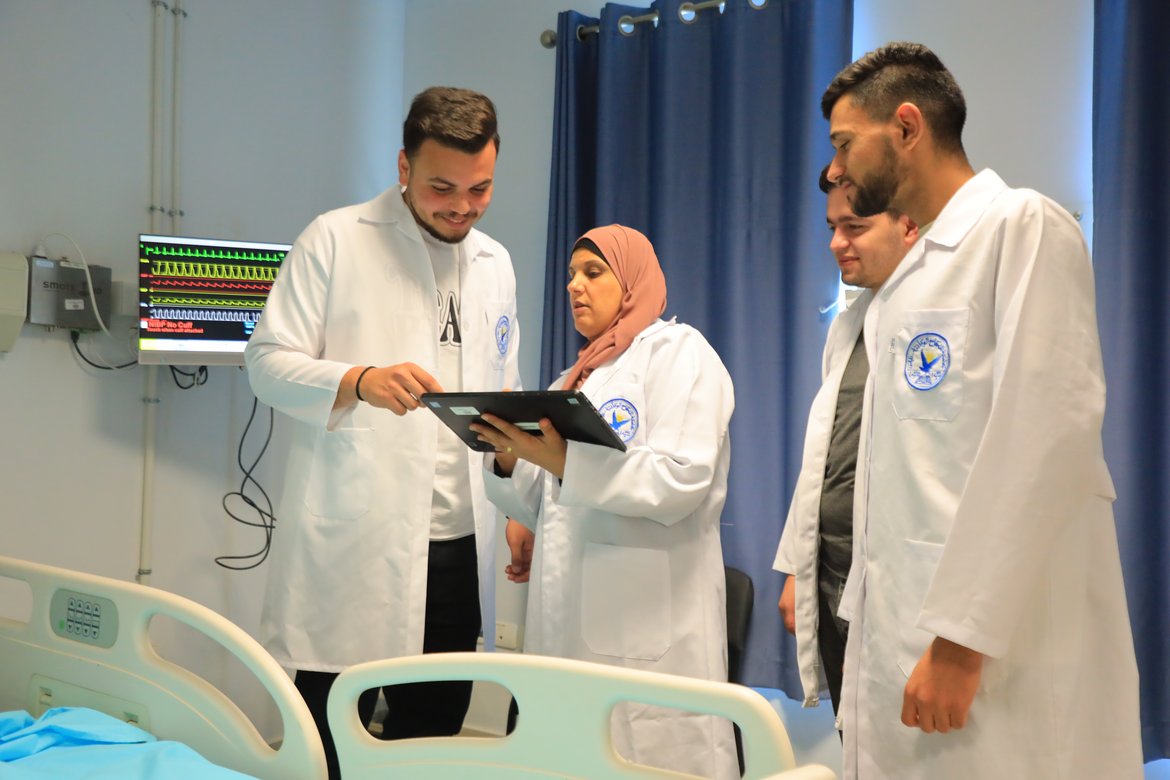Vision
To be a leader in nursing education by providing an innovative simulation-based learning environment that equips students with the clinical expertise, critical thinking abilities, and compassionate care skills necessary to excel in modern healthcare settings and deliver high-quality patient care.
Mission
The Simulation Lab at the College of Nursing is committed to providing a state-of-the-art educational space that empowers nursing students to develop and refine their clinical skills in a realistic and supportive environment. Through simulated patient care scenarios, students engage in hands-on learning experiences that enhance their ability to respond effectively to medical emergencies, provide comprehensive care, and collaborate within healthcare teams. Our mission is to ensure that every nursing student graduates with the confidence, competence, and compassion required to excel in their professional practice, ultimately improving patient outcomes and advancing healthcare delivery.
Objectives
- Skill Mastery Through Practice: Provide nursing students with the opportunity to repeatedly practice essential nursing skills in a safe, controlled environment, ensuring they become proficient and confident in their abilities.
- Development of Clinical Reasoning: Encourage the development of clinical reasoning, decision-making, and problem-solving skills through exposure to a variety of patient scenarios that mimic real-world challenges.
- Promotion of Patient-Centered Care: Help students develop a holistic approach to patient care that includes physical, emotional, and psychological support, fostering empathy and cultural sensitivity in all interactions.
- Teamwork and Interprofessional Collaboration: Promote effective communication and teamwork among nursing students and students from other healthcare disciplines, preparing them to function as part of a collaborative healthcare team.
- Simulation-Based Learning for All Stages: Cater to all stages of learning, from foundational skills for beginners to complex decision-making for advanced students, adapting scenarios to the learner’s level.
- Integration of Technology in Education: Leverage advanced simulation technology to replicate realistic clinical environments, enhancing the learning experience and improving the transfer of knowledge to real-world practice.
- Patient Safety and Ethics: Educate students on the importance of patient safety protocols, ethical considerations in nursing practice, and the importance of adhering to professional standards of care.
Description
The Simulation Lab at the College of Nursing is designed to replicate the dynamic and high-pressure environment of real-world clinical settings. With cutting-edge technology, our simulation facilities offer an array of patient care scenarios, from routine check-ups to complex, life-threatening emergencies. Students are provided with the opportunity to engage in hands-on experiences using high-fidelity patient simulators that exhibit realistic physiological responses to medical interventions. These simulators allow students to gain critical experience in areas such as:
- Basic and Advanced Patient Assessment: Learn to assess patients, take histories, perform physical exams, and make initial diagnoses based on their findings.
- Emergency Care and Life-Saving Procedures: Practice performing CPR, managing cardiac arrest, handling trauma patients, and responding to acute medical crises.
- Medical-Surgical Nursing Skills: Hone skills for patient management, wound care, intravenous therapy, and administering medications.
Our Simulation Lab is equipped with a variety of mannequins, ranging from basic simulators to high-fidelity models capable of simulating real-time physiological changes such as heart rate, blood pressure, respiratory function, and even childbirth. This enables students to practice everything from routine assessments to emergency interventions, giving them the opportunity to make decisions in a supportive and low-stress environment.
Moreover, students benefit from detailed debriefing sessions after each simulation. During these sessions, they receive constructive feedback from instructors, peers, and healthcare professionals, allowing them to reflect on their performance, discuss alternative approaches, and enhance their decision-making processes for future situations.
Additionally, the lab provides an opportunity to learn and practice patient safety protocols, such as infection control, medication safety, and the prevention of adverse events, ensuring that students understand the importance of maintaining high standards of care at all times.
Through these simulations, students gain not only technical proficiency but also confidence, clinical reasoning skills, and a compassionate approach to patient care. The Simulation Lab is not only an educational resource but also a key component in the development of competent, compassionate, and professional nurses who will be prepared to meet the healthcare needs of diverse patient populations.
The Junior Pediatric Simulation Lab at the College of Nursing is specifically designed to introduce nursing students to the fundamentals of pediatric care in a safe and immersive learning environment. By simulating common pediatric medical scenarios, students gain the opportunity to practice essential skills and build their confidence in handling pediatric patients, ranging from infants to adolescents.
Vision
To provide a comprehensive, interactive, and realistic pediatric simulation experience that prepares nursing students to deliver safe, effective, and compassionate care to children in diverse healthcare settings.
Mission
The mission of the Junior Pediatric Simulation Lab is to enhance the clinical education of nursing students by offering hands-on, high-fidelity pediatric simulations. Through these simulations, students develop critical pediatric care skills, improve their decision-making abilities, and learn to manage common pediatric conditions and emergencies in a controlled, supportive environment.
Objectives
- Pediatric Skill Development: Equip students with the necessary clinical skills to assess, diagnose, and treat pediatric patients through real-world simulation scenarios.
- Emergency Response Training: Provide students with the opportunity to practice handling pediatric emergencies such as respiratory distress, seizures, and trauma, enabling quick and effective responses.
- Family-Centered Care: Teach students the importance of providing care that respects and involves families in the healing process, fostering effective communication with both pediatric patients and their families.
- Patient Safety and Risk Management: Educate students on pediatric safety protocols, including infection control, medication administration, and appropriate equipment use for younger patients.
- Cultural Sensitivity and Empathy: Promote understanding and compassion in the care of children from diverse backgrounds, ensuring a holistic approach to pediatric nursing.
- Professional Development: Build students’ confidence and professionalism through structured, reflective learning experiences, promoting lifelong learning in pediatric nursing practice.
Description
The Junior Pediatric Simulation Lab is an innovative educational resource designed to replicate a variety of pediatric patient care scenarios. The lab is equipped with specialized pediatric mannequins that allow students to engage in life-like situations involving infants, toddlers, children, and adolescents. These mannequins are capable of displaying a wide range of symptoms, from common illnesses to critical conditions, enabling students to practice and refine their clinical decision-making and nursing skills.
Key features of the lab include:
- Pediatric Patient Simulators: High-fidelity mannequins that mimic a wide range of pediatric conditions, from routine assessments to urgent care situations, such as pediatric respiratory distress, fever, and dehydration.
- Emergency Pediatric Care: Simulation of pediatric emergencies such as choking, anaphylaxis, and seizures, allowing students to practice life-saving procedures like CPR and airway management.
- Patient and Family Interaction: Scenarios designed to improve communication with young patients and their families, emphasizing empathy, support, and education in pediatric care.
- Developmentally Appropriate Care: Students learn to provide care tailored to the developmental stage of each pediatric patient, from newborns to older children, understanding how their physiological and emotional needs differ.
- Clinical Decision-Making: Students engage in scenarios that require them to make rapid decisions in response to changes in the patient’s condition, developing their critical thinking and problem-solving abilities.
By using this lab, students gain valuable hands-on experience that will ensure they are well-prepared for real-world pediatric clinical practice. With a strong focus on safety, effective communication, and patient-centered care, the Junior Pediatric Simulation Lab plays a vital role in shaping confident, skilled, and compassionate pediatric nurses.
The Sim Mom lab at the College of Nursing is dedicated to providing nursing students with the opportunity to engage in comprehensive maternal care simulations. This lab replicates real-world labor and delivery scenarios, postpartum care, and other obstetric emergencies, offering students a realistic and immersive learning environment. The goal is to prepare Midwifery and nursing students with the essential skills and knowledge required to provide high-quality, patient-centered care to mothers and newborns.
Vision
To be a leading educational facility that empowers nursing students with the skills, knowledge, and confidence needed to deliver exceptional maternal and newborn care, with a focus on improving outcomes for mothers and babies in diverse clinical settings.
Mission
The mission of the Sim Mom lab is to provide midwifery and nursing students with a hands-on, high-fidelity simulation experience in maternal care. Through simulated childbirth and postpartum scenarios, students enhance their clinical decision-making, critical thinking, and patient communication skills. The lab also emphasizes teamwork, cultural sensitivity, and patient safety to ensure students are well-prepared to manage both routine and complex maternal care situations.
Objectives
- Labor and Delivery Skills: Provide students with the opportunity to practice and perfect the skills required for managing labor and delivery, including monitoring fetal heart rate, administering pain relief, and assisting with the birth process.
- Postpartum Care: Ensure students are capable of delivering high-quality postpartum care to mothers, including monitoring for complications such as hemorrhage and infection.
- Maternal Emergency Response: Train students to handle obstetric emergencies such as preeclampsia, eclampsia, shoulder dystocia, and postpartum hemorrhage, ensuring they can respond promptly and effectively.
- Newborn Care: Teach students the essential skills for neonatal resuscitation, including proper assessment, stabilization, and communication with parents about newborn care.
- Teamwork and Communication: Foster collaboration with multidisciplinary teams to deliver integrated maternal and neonatal care, emphasizing effective communication and leadership during critical moments.
- Patient Education and Advocacy: Promote the importance of patient education and advocacy in maternal health, ensuring students understand the significance of involving mothers in their care decisions.
Description
The Sim Mom lab is an advanced simulation space equipped with state-of-the-art maternal and newborn mannequins, designed to replicate real-life scenarios in maternal healthcare. Through the use of high-fidelity simulators, students engage in various clinical situations, including normal labor and delivery, complicated childbirth, and post-delivery care, all of which require a rapid, well-coordinated response.
Key features of the Sim Mom lab include:
- Labor and Delivery Simulators: High-fidelity mannequins designed to simulate the entire process of labor, from early contractions to the delivery of the baby. These mannequins can simulate various complications, such as breech birth, fetal distress, and abnormal presentations.
- Postpartum Care Simulation: Simulations to practice monitoring maternal health post-delivery, including assessing uterine tone, controlling bleeding, and preventing complications such as infection or thrombosis.
- Neonatal Resuscitation: Advanced mannequins that simulate neonatal resuscitation needs, such as assisting with neonatal airway management, breathing support, and the assessment of newborn health immediately after delivery.
- Maternal Emergencies: Simulated obstetric emergencies, including preeclampsia, uterine rupture, eclampsia, shoulder dystocia, and postpartum hemorrhage, which require immediate, life-saving interventions.
- Patient Education and Counseling: Scenarios that emphasize communication and patient education, allowing students to practice educating mothers about birth plans, pain management options, and postpartum care.
- Multidisciplinary Collaboration: Opportunities for nursing students to collaborate with students from other healthcare disciplines (e.g., medicine, midwifery, and pharmacy), enhancing teamwork skills and providing holistic maternal care.
Through the Sim Mom lab, students can repeatedly practice key skills in maternal care, improving their ability to respond to any situation with confidence. The lab is a vital resource for developing nursing students' clinical judgment, emotional intelligence, and hands-on expertise.
By engaging in high-fidelity simulations, students learn to handle the pressures of real-world maternal healthcare, develop a compassionate approach to care, and understand the importance of collaboration and communication during labor and delivery. The Sim Mom lab ensures that students are fully equipped to provide high-quality, safe, and compassionate care to mothers and newborns.

